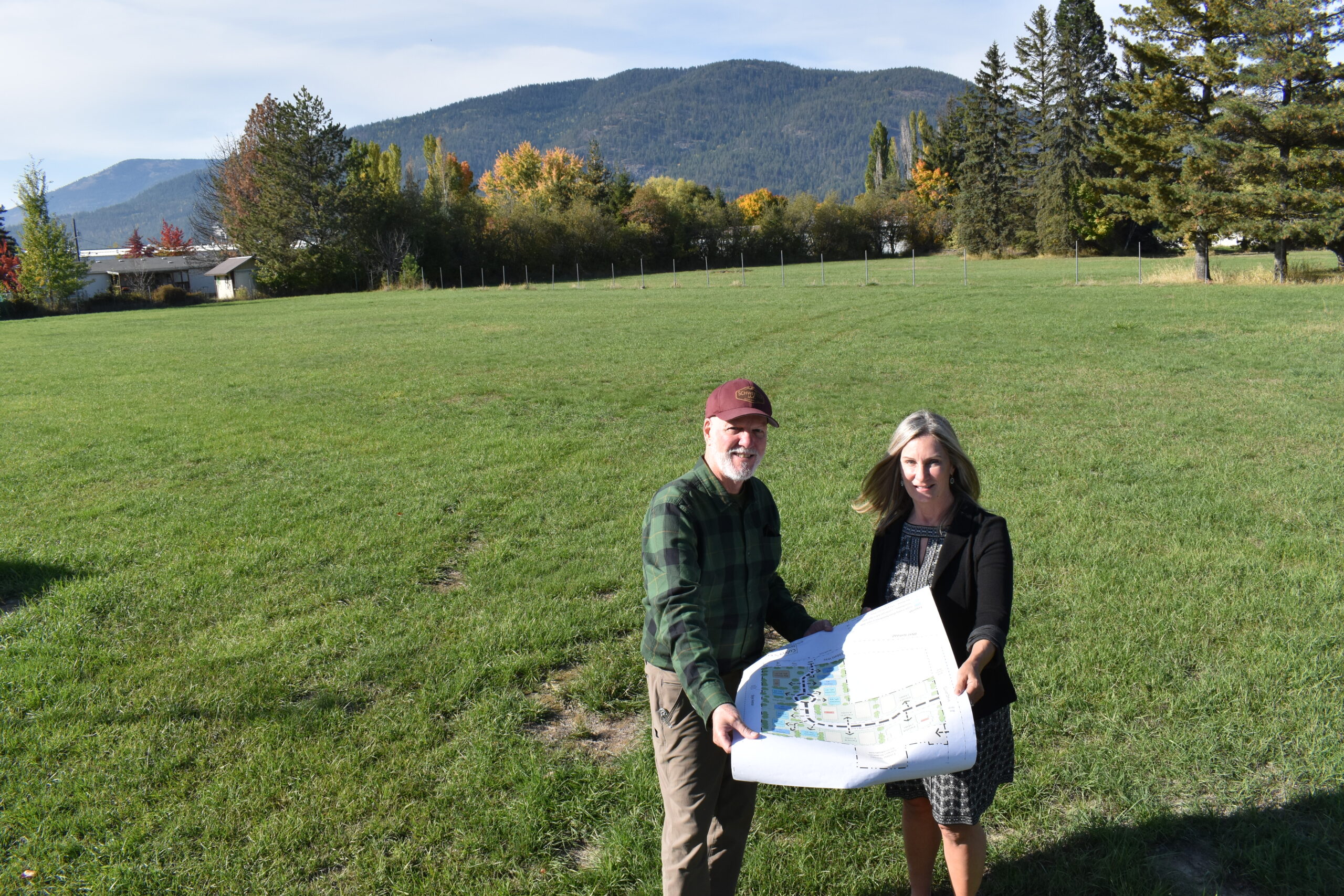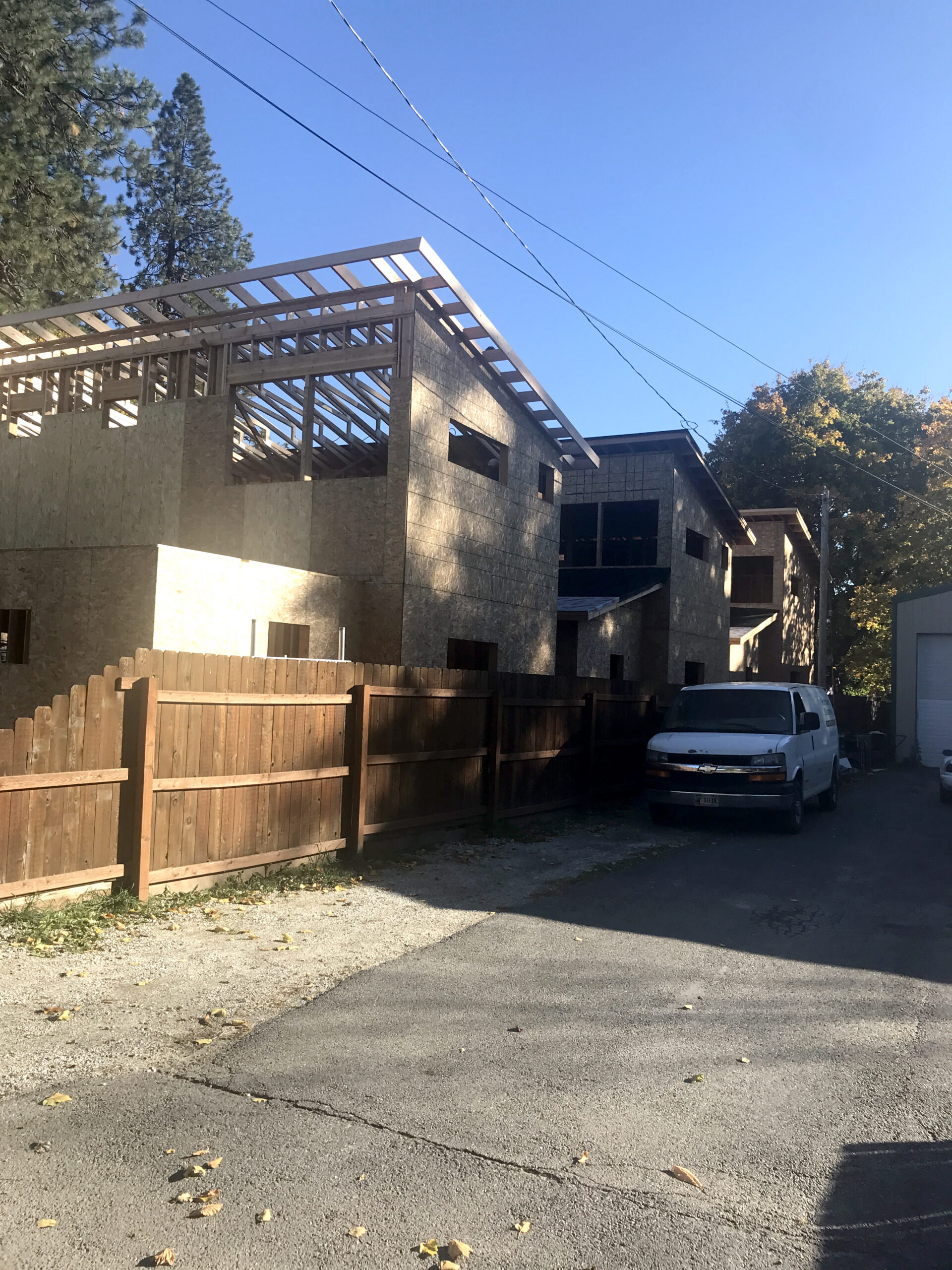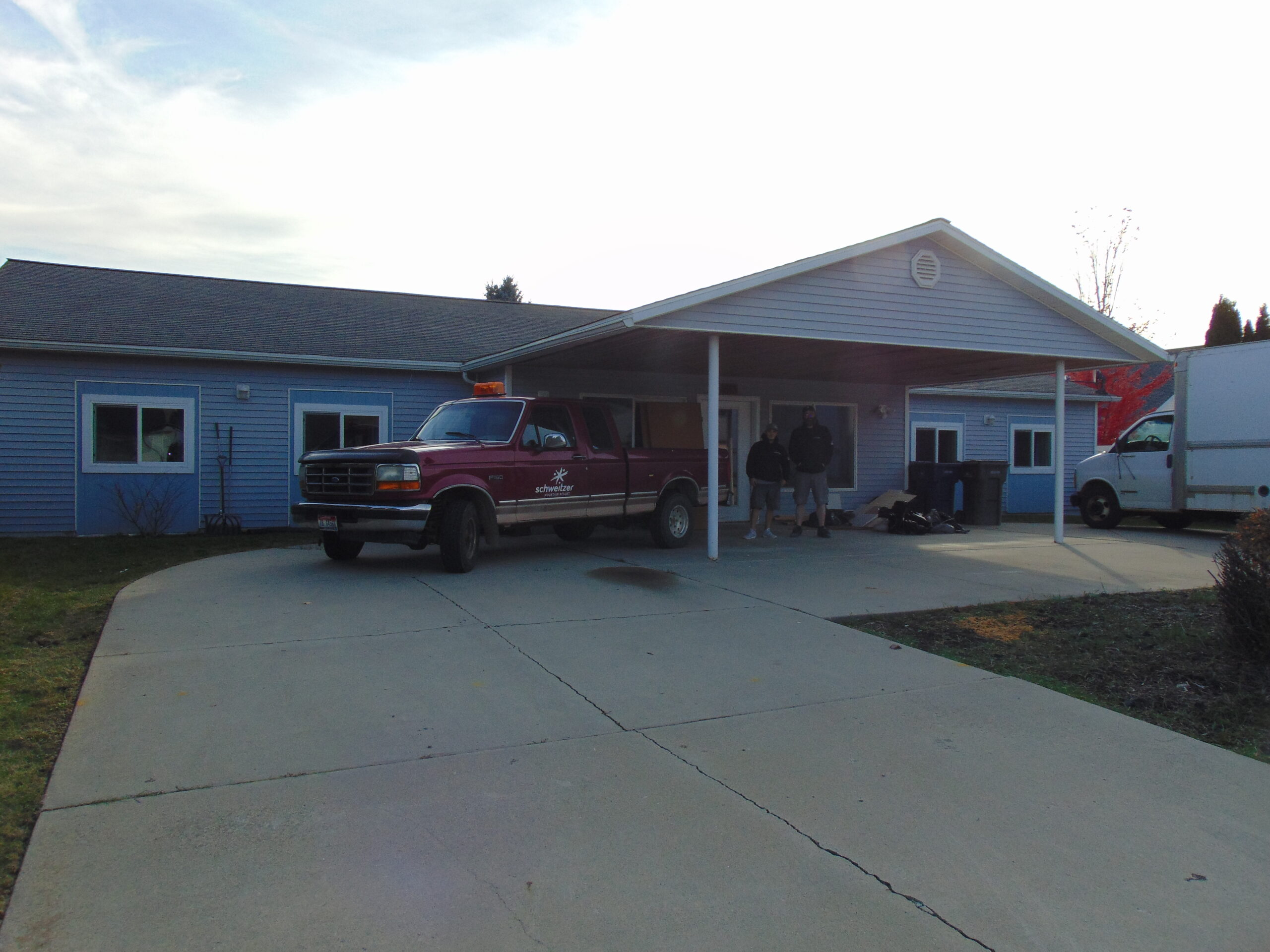Priced Out!
From the Winter 2022 Issue
Area housing crisis is sparking community action

Bonner County Housing Agency’s Rob Hart, and property owner Nancy Hadley, look over plans for the proposed Culver’s Crossing development. Photo by Chris Bessler.
Sandpoint spent the summer swirling in a housing maelstrom that is pricing local workers out of the market for a place to live. Purchase prices were sky high and even some long-term renters found their rent increased into the unaffordable realm.
This summer, homes sold seemingly by osmosis without ever going on the market, or had three offers over the asking price the moment “For Sale” signs appeared in their yards. “We’re a very thin market,” said Raphael Barta, a long-time real estate agent in town. “At the best of times, we don’t have a ton of inventory on the market. If you get a shock of demand, and you had a relatively fixed inventory to start with, you’re overwhelmed.”
Not only did homes sell fast, they sold for prices no one had ever seen here before. LendingTree, a national lender, gave Sandpoint the dubious honor of being one of the most expensive towns in America. Exact numbers are hard to nail down, because Idaho doesn’t require that sales price be part of the public record when property is transferred. But for properties sold through the MLS, the median price of a home (April-September) was $600,000. Prices eased in autumn as they often do, but not nearly to the level they had been at just a year previously, when the comparable median price had been closer to $385,000. Few homes came on the market that could be purchased with the Sandpoint area median income of approximately $64,000, and builders were not building many more.
Rents soared as well, although the bigger problem was finding a rental at all. Long-time renters had homes sold out from under them and could not find another rental in their price range. As the summer waned, formerly hopeful buyers gave up on what Sandpoint’s mayor Shelby Rognstad called “a market that’s pretty wildly out of control” and snapped up what rentals there were. Realtor.com showed only one rental available in the greater Sandpoint area in mid September, and a local Facebook page for rentals was primarily filled with more “looking to rent” posts than there were actual rentals available.

This 25-acre parcel near the airport, owned by Litehouse, Inc., is currently under consideration for residential development. Photo by Trish Gannon.
This problem is neither local nor unique, but Sandpoint as a resort and retirement town has some factors that exacerbate the issue. Population is growing rapidly, and many newcomers bring equity to spend from homes they sold elsewhere at even higher prices. Investors buy homes to use as short-term rentals for vacationers; they can get more out of their investment this way than by renting long-term to a local worker. As homes come on the market, local workers must compete not only with newcomers but with people who are shopping for second homes, with investors scouting out properties for a short-term rental business, and with speculators looking to turn a profit. A local, middle-income worker couldn’t compete this past summer as home prices rose over half a million dollars.
When the last real estate boom hit in 2008, it was followed by a crash that allowed Sandpoint some breathing room to start to address some of the problems that had become evident. The city set a limit on the number of houses that could be used as short-term rentals. Zoning changes were made that allowed for more multifamily housing and smaller lot sizes. Restrictions were eased on ADUs—accessory dwelling units or “granny flats”—so that more housing could be built on each lot.
As the current crisis loomed, the city commissioned a report on housing that was presented in November of 2019. It had three pages of action ideas. Then COVID-19 hit, the planning director left a reshuffled planning department, and efforts to address the housing issue seemed to stall. In response to a survey the city conducted this summer, over half of business owners agreed with the statement “Current housing conditions detract from the success of my business.”
By late summer, Mayor Rognstad had convened a task force of 25 people representing businesses, employers, and developers as well as local government and nonprofits. Its purpose is to provide insight and creative suggestions, and to review the 2019 report. While the group’s size makes it inclusive, the number of members also makes it difficult to find a time when everyone can attend meetings. As of press time, the task force had met twice. The mayor anticipated that the group’s proposals would come primarily in the form of recommendations for changes to the city’s comprehensive plan.
In the meantime, however, private individuals, agencies, and employers have taken the problem into their own hands.
“The resort industry tends to attract individuals who like to work at different resorts every couple of years, and without affordable housing options this population will not be able to come to Sandpoint to work,” explained Scot Auld, human resources director at Schweitzer. For these short-term workers, the resort has purchased and is remodeling a former assisted-living facility to provide eight bedrooms and a large common kitchen, dining, and recreation room.
It also owns two multifamily residential units on the mountain that it will make available to employees this winter. “Altogether these units will have space for a maximum of 28 employees,” said Auld, but added: “Of course, with over 700 employees in the wintertime, this is only a small step.”
Meanwhile, local businesses are considering what else they can do not only for short-term workers, but for their middle-income, full-time employees. “The most recent surge in home and rental prices has started to drive out some of our existing employees, some of whom have worked and lived here for years,” said Auld.
Litehouse, another large employer in the area, is seeking a rezone from the city on behalf of a developer interested in purchasing 25 acres of land they own west of the airport in order to allow additional housing to be built. The Planning and Zoning Commission asked the request only be allowed with a development agreement for worker housing. City council was considering the request at presstime.
Bonner Community Housing Agency Director Rob Hart is confident that building housing that middle-class, local workers can afford can be profitable. For their Income-Based Local Housing Program, “We’re looking for landowners interested in making a profit and helping the community,” said Hart. “It’s not something you do as a volunteer or for a gift. It’s a for-profit program.”
BCHA does this by removing some costs that developers would otherwise incur. “We take the developer fee out of it, we take real estate agents out of the picture, plus we build small homes.” The program reverse-engineers homes and costs to what local workers can afford. His agency charges a small fee that just covers the expenses of its part-time office.
The first development to be built using this program, in a partnership with landowner Nancy Hadley, is already under way. Culver’s Crossing will include 49 units on six acres in north Sandpoint. To make sure these homes go to local workers rather than to developers or speculators, purchases in Culver’s Crossing will be restricted to qualified buyers, who will be defined as individuals who earn between 70 percent and 120 percent of Sandpoint’s area median income.
Culver’s Crossing will also use deed restrictions. In this case, this means that buyers must be employed locally, or must be seniors or disabled. (This language prevents the development from running afoul of state laws that require nondiscrimination in housing.) Buyers must also live in the home and own it for at least two years. After that, the home is theirs to continue living in or to sell as they wish.

The city of Sandpoint has relaxed some planning regulations in order to allow for greater density of buildings on a parcel.
Employers that own land can use that land to provide housing restricted to their employees using BCHA’s Employer Directed Workforce Housing Program. “Employers can make a profit if they build housing for their employees,” said Hart. The employer might build homes to rent to its employees, or it can sell homes to its employees with deed restrictions that require the employee-owners to sell the homes back to the employer when they are ready to leave. Employees make mortgage payments that allow them to start building equity, and these agreements also usually include a clause that the employer will pay some kind of appreciated amount for the house when the employer buys it back, often related to the Consumer Price Index.
Another approach to reducing the cost of housing is using a community land trust. In this case, the buyer buys the home but not the land, which is owned by the trust. Many locals are familiar with Kaniksu Land Trust as the owner of Pine Street Woods and as an organization that protects open space through conservation easements. “Part of community conservation is looking at what our communities are struggling with,” said its Executive Director, Katie Cox. “Making urban centers more livable, useful, and affordable helps KLT to protect and keep open working forest, farm, and ranch land.”
At their September meeting, KLT board members agreed they should work to be conserving land for housing as well as open space. Using this approach, private landowners or employer-landowners get a tax saving when they donate land to the trust, and this can offset the cost of developing housing. Any landowner, employer, or individual investor could contribute to the supply of housing in this way.
The city cannot put its land into a trust, because it is required by statute to sell its land to the highest bidder. But Mayor Rognstad has another idea for how city land can be used for housing. “I’ve been advocating for council to purchase land for a park plus 15 acres adjacent to the disc golf course,” he said in September. This land could be part of a new urban renewal district (the city already has two others) to be used for housing. The city council will consider this fall what to do with that property.

Workers call it a day at this former retirement home in Sandpoint Schweitzer purchased in order to provide housing for needy employees. Photos by Trish Gannon.
Ultimately, it will take community commitment and effort to ensure that Sandpoint regains its ability to welcome and house people with a wide variety of incomes and occupations.
BCHA has some thoughts about that. In the first week of September, its board decided they would pursue an additional strategy. They were concerned that local landowners, sellers, builders, and real estate agents did not realize how their individual selling practices collectively contributed to the problem we have today. They decided to implore these people not to sell to speculators, but instead to sell to local employees and other locals who had incomes under half the price of the homes they were selling. “If even 10 percent of the sales in Sandpoint in the next 12 month follow this plan, then we can go a long way to solving the housing crisis,” said their request.
While this wouldn’t necessarily bring home prices down into the range that a middle-income worker could afford, it would remove speculators and corporations from the process. BCHA was confident that sellers could still make money with qualified buyers, but the housing would remain or become available to local people who need a place to live, rather than to distant corporations or others who don’t live here.
As the fall progressed, interest in BCHA’s programs grew, and it was working on more than 500 units between Athol and Bonners Ferry, to be built over the next three to five years.
“We all want an immediate solution, and unfortunately it’s not that kind of problem,” said Rognstad. But city government can’t wait for nonprofits to take care of it, and employers can’t wait for agencies, and landowners can’t wait for developers, and working people can’t wait for anyone.
“Something’s gotta happen,” said Barta. “People are out of hope.”
Auld agrees that something needs to be done. “We are very much aware of the need for housing. It’s a big challenge that’s not getting any easier, and it’s not going away. The future of our local businesses and our employees depends on our community finding a way to make this happen.”




Leave a comment